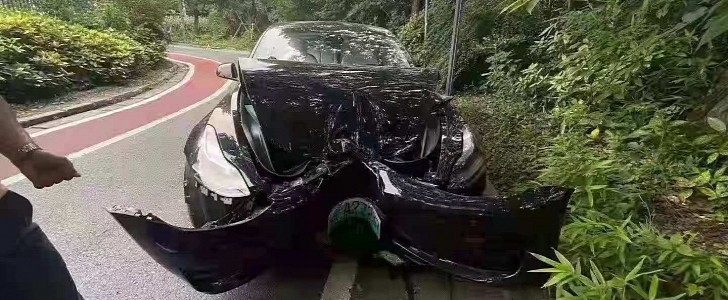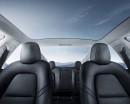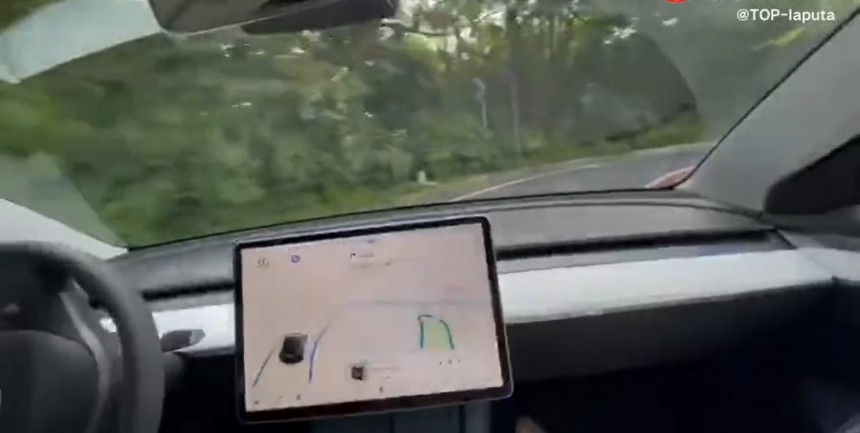It's been way too long since the last somewhat scandalous crash involving Tesla's Autopilot made the news, so, sure enough, here is a fresh new one coming from China.
Well, since it happened in China and every information surrounding it is in Chinese, we can't verify the authenticity of the date. As it stands, it looks like it was first uploaded yesterday (by Weibo user TOP-laputa), the 4th of July, so it is probably recent.
Could anyone honestly say after watching the whole clip that it was the car's fault? It's a difficult one to call, and, anyway, all crashes involving Autopilot are ultimately the driver's fault because they are supposed to pay attention and intervene whenever the system acts up. With that in mind, assigning blame isn't the right way to go about this.
The question we should ask is whether the Autopilot could and should have done better. And to that question, the answer is a definite "yes." The driver used the advanced driver aid system (ADAS) on a marked, one-lane one-way road with speed set at "30." We can't tell whether that's mph or kph, but judging by how far the car is going, we tend to think it's the former (which means it was doing just under 50 kph).
Either way, it's a reasonable speed for the conditions, and we wouldn't be surprised if it were the legal speed limit as well. The car does a good job at remaining centered in the single lane, but when the road goes over a slight crest and takes a turn to the right after, things go south.
In this situation, as they came to the top of the crest, a human driver would notice the arrow on the pavement pointing to the right and the road itself bending in the same direction and plan accordingly. That means doing one of the two, or even both: reduce the speed and move to the left of the road to have a flatter trajectory through the bend.
The Autopilot, on the other hand, does absolutely nothing. The problem is it continues to do nothing for a very long time, even after the road had begun to swerve to the side. The odd thing is that the graphics on the screen show the system is aware of the bend, yet the vehicle was still late and slow to react. Ultimately, it prompts the driver to take control, but it's only fractions before the EV leaves the road surface and smashes into one of the trees on the side.
The Autopilot's performance is undeniably shocking, but not more so than the driver's lack of reaction. However, you could explain that by the false confidence earned after countless miles of using the Autopilot coupled with Tesla's (through the voice of its CEO) often unfounded claims about the Autopilot's ability.
In this scenario, a reasonable driver would have hovered their hands over the steering wheel and their foot over the brake pedal and cut in whenever something seemed out of the ordinary. Reacting one second earlier would have prevented the crash, and there were plenty of signs that a less reckless driver would have picked on and made the correct decision to take control.
But that's what happens when you turn customers into volunteering test drivers—they take unnecessary risks and do stupid things. As for the Autopilot, it's hard to tell exactly what went wrong, but there could be a few things.
The fact there was no car in front of it didn't help. Then, the video makes it seem like the turn was in a heavily shaded area, so the contrast between the white lines and the gray asphalt wasn't as high. The road was also on a descending gradient, making brakes less effective. Finally, some people say the relatively high speed, as well as the tight bend, meant the Autopilot's steering torque limitation was reached, and the system couldn't technically steer any sharper.
If that's the case, then it's one more thing that Tesla needs (or rather needed) to take care of. Based on the GPS maps and its own sensors reading the road, its ADAS should be able to predict when this limitation might be reached after factoring in the vehicle's speed and either slow down or tell the driver to jump in a lot sooner.
Another weird aspect about the crash is that the Model 3's airbags were not deployed. Granted, the two occupants were OK and were able to walk out of the car, but based on the footage and an image of the aftermath, it looks like it was a pretty violent collision. The large crumpling zone at the front made sure the tree was kept away from the driver and his passenger, but we can only hope that not activating the airbags was a conscious decision on the part of the vehicle's systems not a malfunction.
Could anyone honestly say after watching the whole clip that it was the car's fault? It's a difficult one to call, and, anyway, all crashes involving Autopilot are ultimately the driver's fault because they are supposed to pay attention and intervene whenever the system acts up. With that in mind, assigning blame isn't the right way to go about this.
The question we should ask is whether the Autopilot could and should have done better. And to that question, the answer is a definite "yes." The driver used the advanced driver aid system (ADAS) on a marked, one-lane one-way road with speed set at "30." We can't tell whether that's mph or kph, but judging by how far the car is going, we tend to think it's the former (which means it was doing just under 50 kph).
Either way, it's a reasonable speed for the conditions, and we wouldn't be surprised if it were the legal speed limit as well. The car does a good job at remaining centered in the single lane, but when the road goes over a slight crest and takes a turn to the right after, things go south.
In this situation, as they came to the top of the crest, a human driver would notice the arrow on the pavement pointing to the right and the road itself bending in the same direction and plan accordingly. That means doing one of the two, or even both: reduce the speed and move to the left of the road to have a flatter trajectory through the bend.
The Autopilot's performance is undeniably shocking, but not more so than the driver's lack of reaction. However, you could explain that by the false confidence earned after countless miles of using the Autopilot coupled with Tesla's (through the voice of its CEO) often unfounded claims about the Autopilot's ability.
In this scenario, a reasonable driver would have hovered their hands over the steering wheel and their foot over the brake pedal and cut in whenever something seemed out of the ordinary. Reacting one second earlier would have prevented the crash, and there were plenty of signs that a less reckless driver would have picked on and made the correct decision to take control.
But that's what happens when you turn customers into volunteering test drivers—they take unnecessary risks and do stupid things. As for the Autopilot, it's hard to tell exactly what went wrong, but there could be a few things.
The fact there was no car in front of it didn't help. Then, the video makes it seem like the turn was in a heavily shaded area, so the contrast between the white lines and the gray asphalt wasn't as high. The road was also on a descending gradient, making brakes less effective. Finally, some people say the relatively high speed, as well as the tight bend, meant the Autopilot's steering torque limitation was reached, and the system couldn't technically steer any sharper.
If that's the case, then it's one more thing that Tesla needs (or rather needed) to take care of. Based on the GPS maps and its own sensors reading the road, its ADAS should be able to predict when this limitation might be reached after factoring in the vehicle's speed and either slow down or tell the driver to jump in a lot sooner.
Another weird aspect about the crash is that the Model 3's airbags were not deployed. Granted, the two occupants were OK and were able to walk out of the car, but based on the footage and an image of the aftermath, it looks like it was a pretty violent collision. The large crumpling zone at the front made sure the tree was kept away from the driver and his passenger, but we can only hope that not activating the airbags was a conscious decision on the part of the vehicle's systems not a malfunction.
????????
— TC (@TESLAcharts) July 4, 2021
Full video of Autopilot crash in China.
What a joke. $TSLAQ
H/T @BradMunchen pic.twitter.com/1tyEmQvOY0
























